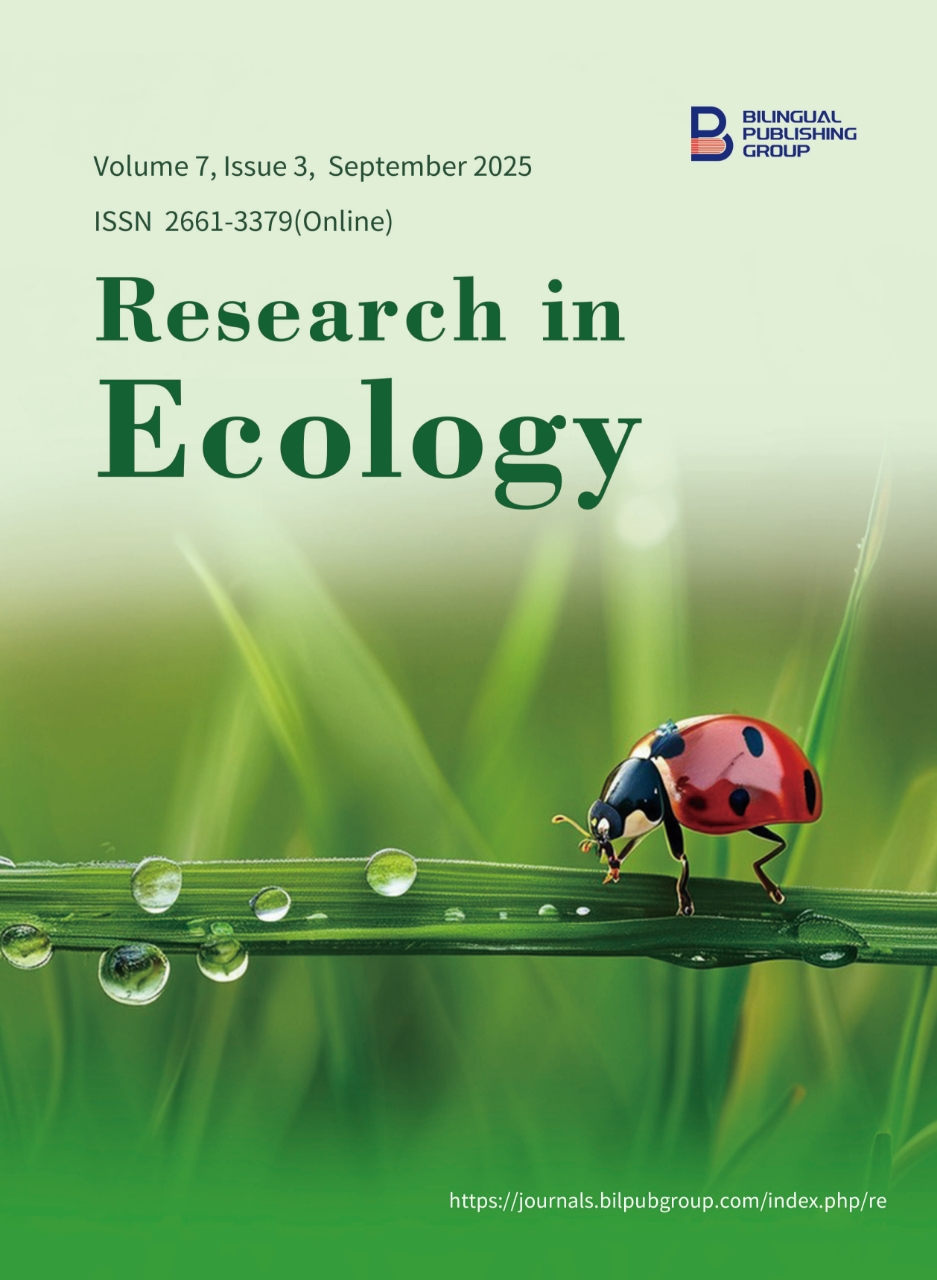
Dynamic Landslide Susceptibility Modeling and Risk Forecasting in the Nilgiris Using Geospatial Approaches
DOI:
https://doi.org/10.30564/re.v7i3.10004Abstract
Landslides remain a significant environmental hazard in India's hill regions, particularly in the Nilgiris district of Tamil Nadu, due to its steep terrain, fractured geology, and heavy seasonal rainfall. This study applies the Frequency Ratio (FR) model within a GIS and remote sensing framework to map landslide susceptibility and identify key contributing factors to slope instability. Ten thematic layers were used, including land use/land cover (LULC), NDVI, slope gradient, soil type and depth, geomorphology, aspect, rainfall, lineament density, and lineament proximity—derived from geological databases, DEMs, and satellite imagery. A landslide inventory was analyzed statistically to evaluate each factor’s role in landslide occurrence. Results indicate that slope gradient (9.15%) and LULC (8.37%) are the most influential factors, followed by geomorphology (7.78%), soil type (7.48%), and lineament density (4.50%). A key innovation of this study is the integration of lineament buffer zones to assess the influence of structural discontinuities, often overlooked in regional models. The model's predictive performance was validated using the Area Under the Curve (AUC) method, yielding a value of 0.879, indicating high accuracy. The resulting susceptibility map categorizes the landscape into low, moderate, and high-risk zones, providing a critical tool for regional planning, infrastructure development, and disaster management. This research supports climate-resilient development and sustainable land-use planning in vulnerable hill regions, emphasizing that both natural terrain characteristics and human-induced land alterations significantly contribute to landslide risk.
Keywords:
Slope Failure Risk; Frequency Ratio Analysis; GIS-based Mapping; Nilgiris Terrain; Landslide-prone ZonesReferences
[1] Azarafza, M., Akgün, H., Asadi, S., et al., 2021. Deep learning-based landslide susceptibility mapping. Scientific Reports. 11, 24112. DOI: https://doi.org/10.1038/s41598-021-03585-1
[2] Nanda, A.M., Hassan, Z.U., Ahmed, P., et al., 2021. Landslide susceptibility assessment of National Highway 1D from Sonamarg to Kargil, Jammu and Kashmir, India using frequency ratio method. GeoJournal. 86, 2945–2956. DOI: https://doi.org/10.1007/s10708-020-10235-y
[3] Yu, L., Wang, Y., Pradhan, B., 2024. Enhancing landslide susceptibility mapping incorporating landslide typology via stacking ensemble machine learning in Three Gorges Reservoir, China. Geoscience Frontiers. 15(4), 101802. DOI: https://doi.org/10.1016/j.gsf.2024.101802
[4] Dolui, B., Yuvaraj, R.M., Geeth, G., 2020. Statistical analysis on the interrelationship between socio-demographic and anxiety of landslide among the tribal people. Inclusive. 1(17), 257–266.
[5] Alimohammadlou, Y., Najafi, A., Yalcin, A., 2013. Landslide process and impacts: A proposed classification method. CATENA. 104, 219–232. DOI: https://doi.org/10.1016/j.catena.2012.11.013
[6] Chowdhury, M.S., Rahaman, M.N., Sheikh, M.S., et al., 2024. GIS-based landslide susceptibility mapping using logistic regression, random forest and decision and regression tree models in Chattogram District, Bangladesh. Heliyon. 10(1), e23424. DOI: https://doi.org/10.1016/j.heliyon.2023.e23424
[7] Guzzetti, F., Reichenbach, P., Ardizzone, F., et al., 2006. Estimating the quality of landslide susceptibility models. Geomorphology. 81(1–2), 166–184. DOI: https://doi.org/10.1016/j.geomorph.2006.04.007
[8] Jennifer, J.J., Saravanan, S., Abijith, D., 2021. Application of frequency ratio and logistic regression model in the assessment of landslide susceptibility mapping for Nilgiris District, Tamilnadu, India. Indian Geotechnical Journal. 51, 773–787. DOI: https://doi.org/10.1007/s40098-021-00520-z
[9] Mengistu, F., Suryabhagavan, K.V., Raghuvanshi, T.K., et al., 2019. Landslide hazard zonation and slope instability assessment using optical and InSAR data: A case study from Gidole Town and its surrounding areas, Southern Ethiopia. Remote Sensing of Land. 3(1), 1–14. DOI: https://doi.org/10.21523/gcj1.19030101
[10] Raghuvanshi, T.K., Ibrahim, J., Ayalew, D., 2014. Slope stability susceptibility evaluation parameter (SSEP) rating scheme – An approach for landslide hazard zonation. Journal of African Earth Sciences. 99, 595–612. DOI: https://doi.org/10.1016/j.jafrearsci.2014.05.004
[11] Abdo, H.G., 2022. Assessment of landslide susceptibility zonation using frequency ratio and statistical index: A case study of Al-Fawar Basin, Tartous, Syria. International Journal of Environmental Science and Technology. 19(4), 2599–2618. DOI: https://doi.org/10.1007/s13762-021-03322-1
[12] Kanungo, D.P., Arora, M.K., Sarkar, S., et al., 2006. A comparative study of conventional, ANN black box, fuzzy and combined neural and fuzzy weighting procedures for landslide susceptibility zonation in Darjeeling Himalayas. Engineering Geology. 85(3–4), 347–366. DOI: https://doi.org/10.1016/j.enggeo.2006.03.004
[13] Balasubramani, K., Kumaraswamy, K., 2013. Application of geospatial technology and information value technique in landslide hazard zonation mapping: A case study of Giri Valley, Himachal Pradesh. Disaster Advances. 6(1), 38–47.
[14] Chen, W., Sun, Z., Han, J., 2019. Landslide susceptibility modeling using integrated ensemble weights of evidence with logistic regression and random forest models. Applied Sciences. 9(1), 171. DOI: https://doi.org/10.3390/app9010171
[15] Yuvaraj, R.M., Dolui, B., 2023. Geographical assessment of landslide susceptibility using statistical approach. Quaternary Science Advances. 11, 100097. DOI: https://doi.org/10.1016/j.qsa.2023.100097
[16] Sharma, L.P., Patel, N., Ghose, M.K., et al., 2012. Influence of Shannon’s entropy on landslide-causing parameters for vulnerability study and zonation—A case study in Sikkim, India. Arabian Journal of Geosciences. 5(3), 421. DOI: https://doi.org/10.1007/s12517-010-0205-3
[17] Bathrellos, G.D., Skilodimou, H.D., Chousianitis, K., Youssef, A.M., Pradhan, B., 2017. Suitability estimation for urban development using multi-hazard assessment map. Science of The Total Environment. 575, 119–134. DOI: https://doi.org/10.1016/j.scitotenv.2016.10.025
[18] Sonker, I., Tripathi, J.N., Swarnim, 2024. Landslide susceptibility mapping using morphological and hydrological parameters in Sikkim Himalaya: Frequency ratio model and geospatial technologies. Natural Hazards. 120, 6797–6832. DOI: https://doi.org/10.1007/s11069-024-06491-7
[19] Keshri, D., Sarkar, K., Chattoraj, S.L., 2024. Landslide susceptibility mapping in parts of Aglar watershed, Lesser Himalaya based on frequency ratio method in GIS environment. Journal of Earth System Science. 133(1), 1–26. DOI: https://doi.org/10.1007/s12040-023-02204-z
[20] Nath, N.K., Gautam, V.K., Pande, C.B., Moharir, K.N., Rane, N.L., 2024. Development of landslide susceptibility maps of Tripura, India using GIS and analytical hierarchy process (AHP). Environmental Science and Pollution Research. 31, 7481–7497. DOI: https://doi.org/10.1007/s11356-023-31486-5
[21] Reichenbach, P., Rossi, M., Malamud, B.D., et al., 2018. A review of statistically-based landslide susceptibility models. Earth-Science Reviews. 180, 60–91. DOI: https://doi.org/10.1016/j.earscirev.2018.03.001
[22] Hansen, A., 1984. Landslide hazard analysis. In: Brunsen, D., Prior, D.B. (eds.). Slope Instability. John Wiley and Sons: New York, NY, USA. pp. 523–602.
[23] Merghadi, A., Yunus, A.P., Dou, J., et al., 2020. Machine learning methods for landslide susceptibility studies: A comparative overview of algorithm performance. Earth-Science Reviews. 207, 103225. DOI: https://doi.org/10.1016/j.earscirev.2020.103225
Downloads
How to Cite
Issue
Article Type
License
Copyright © 2025 Yuvaraj R M, S. Sanjeevi Prasad, Bhagyasree Dolui, Mijing Gwra Basumatary, Usha Rani, Rody Vanrohnem Faihriem, Harish Kumar, Deshraj Meena, Arun Pratap Mishra, Alka Gagan, Arvind Kumar Sahani, Anjali Bhati

This is an open access article under the Creative Commons Attribution-NonCommercial 4.0 International (CC BY-NC 4.0) License.




 Yuvaraj R M
Yuvaraj R M






